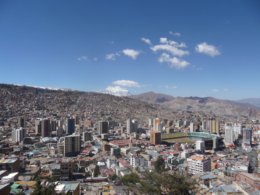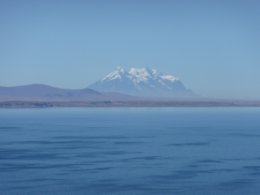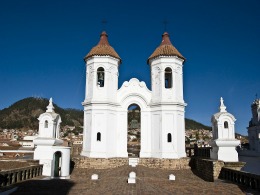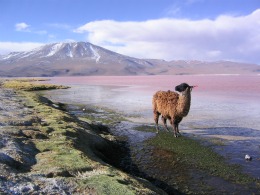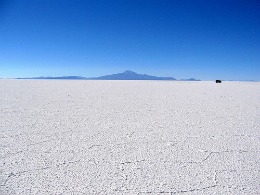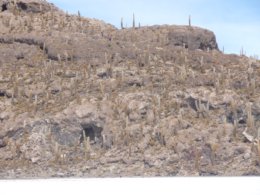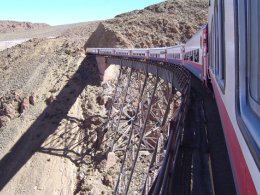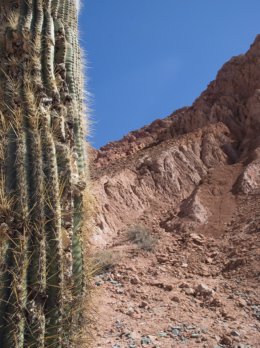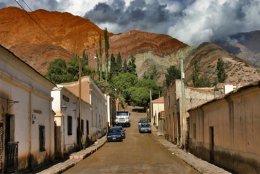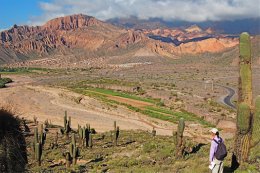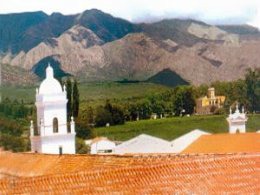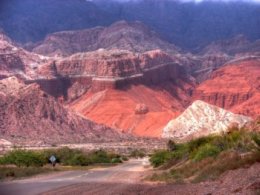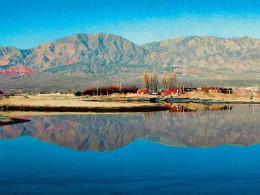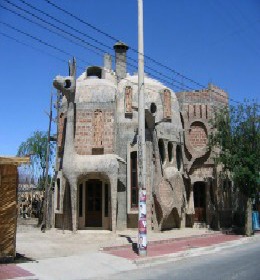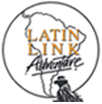Day 1 La Paz – Sucre Fly from La Paz to Sucre. On arrival transfer to your hotel Day 2 Sucre (B) Sucre has some of the finest colonial architecture in the world. See the Constitutional Capital of Bolivia and the seat of the Supreme Court on our morning tour. Sucre is called the white city. It's a city of towers, beautiful churches where the architecture reflects the life of the colonial Spanish aristocracy. Sucre was the birth place of the independence movements of the Americas. In fact, Sucre was the first to rebel against Spanish rule on 25th May 1809. Its colonial past is visible in many religious and civil buildings distributed in the center of the city. Narrow streets, churches, fastidious residences, white facades, red roofs allow us to discover a past of art and religion.In 1991 Sucre was declared Cultural Heritage of Humanity by the UNESCO in light of its Historical and Cultural value. It is neat to just walk around this safe city and take in the different colonial buildings and wonder what life was like years ago. Day 3 Sucre- Potosi (B) This morning travel by bus into the highlands to the UNESCO World Heritage city of Potosi with its rich history and Spanish architecture. Potosi is known as the Imperial City and is situated at the foot of Cerro Rico (Rich Mountain) famed for its mineral wealth. The Spanish created one of the most important and populous cities on the continent, after the discovery of the silver-rich mountain in 1545. Situated at an altitude of more than 13,123ft (4,000m), it is also the highest city in the world although not quite the thriving metropolis that it once was. Potosi was founded in 1546. It soon produced enormous wealth, becoming one of the largest cities in the world with a population of more than 200.000 people. In Spanish there is a saying ´vale un Potosí!´ (´it's worth a Potosí´), which means being worth a fortune. It is from Potosí that most of the Spanish silver came. According to official records, 45.000 tons of pure silver were mined from Cerro Rico from 1556 to 1783. Of this total, 7.000 tons went to the Spanish monarchy. The tradition tells that the Spanish conquerours found incredible amounts of silver, enough to build a bridge completely made out of silver from Potosí to Europe. During the early 19th century, struggles for independence caused many churches to be looted. Then the city's wealth was removed to Europe or to other parts of the Spanish realm. By then the population dropped to less than 10.000. By the time of independence in 1825, the mines of the Cerro Rico were almost exhausted. The opportunity to visit the mines this afternoon Day 4 Potosi (B) Visit to Casa de la Moneda, Convento de Santa Teresa and San Francisco. Tour through the old colonial center with its old narrow streets and mine neighbourhoods Day 5 Potosi – Uyuni (B) This morning we continue across the altiplano to Uyuni then transfer to your hotel on the edge of the salt flats This hotel is one of the most extraordinary in the world, constructed out of blocks of salt. Day 6 Uyuni - Villazon (B,L) The Uyuni Salt lakes area area of impressive beauty Full day visit to the Uyuni Salt Lake.Start your day visiting the huge Uyuni Salt Lake, the cold water springs, the Colchani Salt Factory and Isla Pescado famous for its giant cactus. After lunch continue to Coquesa Mummys and then back to Uyuni .We have arranged use of a hotel room at Hotel Tambo Aymara until late evening when you will be transferred to the railway station Depart on overnight train -executive class Day 7 Villazon - Purmamarca Arrive Villazon early this morning where you will be assisted across the border and connect by comfortable bus to Tilcara and connect by car to the charming town of Purmarmarca Day 8 Purmarmarca - Salta (B) Visit the Seven Colours Mountain surrounding Purmamarca- incredible colours. Then to Tilcara with its archaelogical museum and Indian Fortress (entrance fee to be paid direct Continue on to Humahuaca then visit Leon and Tumbaya.Travel past La Cienaga Dam, Campo Alegre Dam and La Caldera. Travel through Jujuy on the way to Salta Located in the northwest of the Argentine Republic, the province of Salta amazes the tourist with its geographical and cultural heterogeneity. Surrounded by three countries (Chile, Bolivia and Paraguay) and six provinces (Jujuy, Formosa, Chaco, Santiago del Estero, Tucumán and Catamarca), its vast territory covers all kinds of landscapes, from the arid desert of La Puna, to the lush green forest.This region is also the centre of the fruit production, lemons,olives , tobacco for Argentina and has a very pleasant climate at this time of year Day 9 Salta (B) Salta is known not only for its inhabitant’s warmth but also for its cultural heritage. It inherited the diaguita-calchaquí nation of the Inca Empire, a result of the spanish colonial past and the native spirit that fought for national independence. Morning tour of Salta. Day 10 Salta- Train to the Clouds (B) It leaves from the train station at the city of Salta and ends its route at La Polvorilla Viaduct. The railways reach a height of 4,200 meters above sea level, turning this train into one of the highest in the world. The train offers meals onboard, translator services, and medical assistant for any passenger that may be affected by the lack of oxygen caused by the height. The trip lasts approximately sixteen hours, from seven am until midnight or later. The train runs 217 km. and passes through 29 bridges, 21 tunnels, 13 viaducts, 2 spirals, and 2 zigzags. There are two stops throughout the trip: one at San Antonio de los Cobres station, and the other one at La Polvorilla viaduct. It leaves from the city of Salta, the lowest point, and from there it begins the upward route until it reaches the final point at La Polvorilla Viaduct, the highest in the trip. As you reach the different stations, local villagers at picturesque stands sell craftwork, clothes, and regional products as interesting souvenirs of the trip. The train services include dining car, medical practice, audio, video, and bilingual guides. Day 11 Salta – Cafayate (B) Leaving from the City of Salta,tour around one of the most impressive circuits in the Republic of Argentina as you visit the legendary Calchaquí Valley. In order to visit the Calchaquí Valleys and appreciate their beautiful sceneries and the quaint villages from the early XVIII century nestled in their geography, travel a total distance of 520 kilometers through three main roads, namely Provincial Route 33 and National Routes 40 and 68. From the very beginning, fascination takes hold of travelers as they enter the San Fernando de Escoipe Ravine. Surrounded by mountains and bordered by Provincial Route 33, it sets the start of adventure. The local vegetation is typical of the mountain rain forest, with the presence of hydrophile and xerofile plants. Ancient laurels, willows, walnuts, peachtrees, poplars and some conifers are always present in the area. At the end of the Escoipe Ravine, the winding “Cuesta del Obispo” (Bishop's Slope) begins. It got its name from Monsignor Cortázar, the maximum ecclesiastical authority in Salta, who was traveling from Salta to Cachi back in 1622 and spent the night at this spot lying at 3,400 m. At the top of the slope, known as “Piedra del Molino” (Millstone), lies a chapel raised to honor the Archangel Raphael, "Patron Saint of Travelers”. This spot features an unforgettable view of the endless slope, which gets mingled with the granite formation of feldspar, mica and quartz contained in the area. Driving on, there appears a place which faithfully honors its name: the "Enchanted Valley", a dreamed-of place with red soil and green grass where the huge rocks and the uneven terrain astonish the most daring visitors, who are used to being delighted by natural wonders. Continue on to Los Cardones National Park .The road leads to Cachi Pampa – "salt pampa” in the Cacán tongue. After a few kilometers, the Tin Tin Straight is entered. Fully paved, this 12-kilometer-long stretch displays the impressive snow-capped Curacatao summits in the distance. The tour always features the characteristics of the scenery, totally worth beholding. A little further, the town of Cachi opens its gates to show its simple beauty. It is a good moment to make a stop, rest for a while and tour around the purely colonial district. Cachi means “salt” in the Quechua or Cacán tongue, and it was given such a name by the local natives, who had mistaken the summit of Nevado for a big salt deposit. When touring around the village, visitors can appreciate the politeness of the people, who appear to be in tune with the architectural surroundings. Continue through Molinos to the wine growing region of Cafayate Day 12 Cafayate – Salta (B) Cafayate, dunes and vineyards in a fertile valley surrounded by colourful mountains are the best setting to taste delicious wines from an ancient cellar Return through the "Quebrada de las Conchas"(Shells Ravine) where traces of prehistoric times still remain in the many aeolic formations such as The Theatre, The Devil's Throat, The Toad and some others. As we get closer to Salta, the vegetation becomes more lush as we descend down towards the city. Transfer to the airport for your onward flight |
||
Dates & Prices Departures: Thursdays Weekly Prices Per Person NZ$ 3 star 2021-2 Double/twin $3520 Based on a minimum of 2 people travelling Single rates on request |
||
Inclusions: Accommodation in hotel category of your choice – all rooms with private facilities , local service charges & hotel taxes, transfers and tours as specified in the itinerary on a seat in coach basis with local English speaking guides, breakfast daily plus other meals as specified in the itinerary. Exclusions: Airfares,items of a personal nature, tips and gratuities, airport taxes, excess baggage charges, meals not specified in itinerary. Airfares We can provide a separate quotation for the applicable airfares in conjunction with this package. |
||

















